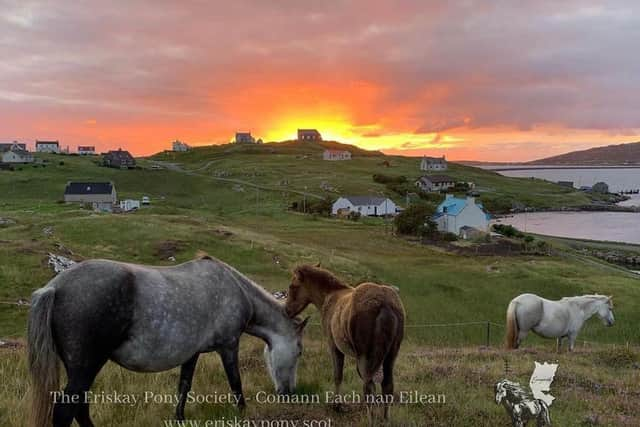Saving rare breed Eriskay ponies on a tiny Scottish island
Now a campaign to raise awareness of the Eriskay Pony – one of three native breeds left in the UK – is underway, with fresh hopes to build an island centre that both celebrates the heritage of the ponies as well as protect their diminishing numbers for the future.
Donald John MacInnes, who has lived on the island all his life and keeps six pure breed ponies, said: “Back in the day, there were something like 70 crofts and ponies were part of life on the island. Everyone had a pony – or you borrowed one.
Advertisement
Hide AdAdvertisement
Hide Ad“They were used for the transport of material, probably the most vital being peat for the fire and seaweed, which would be taken from the shore up to the crofts.


“In the last couple of years, I have started putting harnesses on my ponies to raise awareness of them. I want to go further into that, and bring them to prominence again as working animals and to show the way we were so it doesn’t completely disappear.
“For me, it stems back to memories of childhood, how we looked after the ponies, how your family, friends and neighbours kept them. They were part of island life. People needed the ponies, they were used here up until the 1980s, and that is why they are probably still here .”
The Rare Breeds Survival Trust has put the Eriskay Pony on the ‘critical’ list, which means there are fewer than 300 of the animals left. However, Mr MacInnes said there were probably fewer than 100 pure breed ponies remaining.


Mr MacInnes is a member of the Comann Each nan Eilean - The Eriskay Pony Society, which holds the Stud Book of Origin for the breed and does not allow for cross-breeding, with only 100 per cent Eriskay stallions used.
A separate society does allow cross breeding.
Between 20 to 30 ponies can now be found on Eriskay, with small numbers on neighbouring Barra, Lewis and Harris, as well as parts of the UK mainland. Five foals were born on the islands this year, three of them pure.
Last week, the ponies were put out for winter grazing and will roam free on the island.


.
Mr MacInnes said: "They find their own shelter and the majority of their own food. They tend to go on shore for the extra minerals from the seaweed, but you still keep an eye on them. They normally come up to the house every day.”
Advertisement
Hide AdAdvertisement
Hide AdFundraising is underway in order to build a centre on Eriskay that would showcase the ponies and their heritage. One possible site for the centre is at the old primary school, which closed in 2014 and has now been taken over by Eriskay Heritage Society.
Mr MacInnes said: "The ponies are incredibly endangered. We want to have a dedicated place for our ponies as, at the moment, we don’t have a place where people can come and learn about the ponies and come and experience them, where you can walk out with them and meet their foals.”
It is thought around £140,000 will be needed for the project.
A message from the Editor:Thank you for reading this story on our website. While I have your attention, I also have an important request to make of you.With the coronavirus lockdown having a major impact on many of our advertisers - and consequently the revenue we receive - we are more reliant than ever on you taking out a digital subscription.Subscribe to scotsman.com and enjoy unlimited access to Scottish news and information online and on our app. With a digital subscription, you can read more than 5 articles, see fewer ads, enjoy faster load times, and get access to exclusive newsletters and content. Visit https://www.scotsman.com/subscriptions now to sign up.
Our journalism costs money and we rely on advertising, print and digital revenues to help to support them. By supporting us, we are able to support you in providing trusted, fact-checked content for this website.
Joy Yates
Editorial Director
Comments
Want to join the conversation? Please or to comment on this article.